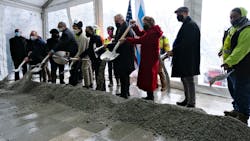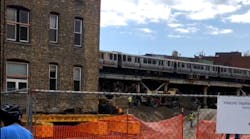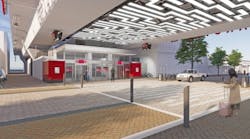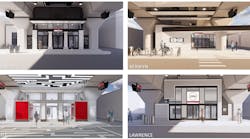CTA wraps up Red-Purple Bypass, begins North Belmont Red-Purple Reconstruction project
Leaders from the Chicago Transit Authority (CTA) were joined by city and state dignitaries to celebrate the completion of the Red-Purple Bypass project, as well as the start of the North Belmont Red-Purple Reconstruction project.
Both are part of the CTA’s $2.1 billion Red and Purple Modernization (RPM) Phase One project, which is the largest reconstruction effort in the authority’s history. RPM will improve rail service reliability, comfort and convenience to customers by modernizing and replacing century-old structures and rail stations from Belmont to Linden in Wilmette, Ill. RPM Phase One includes three major components:
- New Red-Purple Bypass construction followed by the reconstruction of Red and Purple Line track structure between Belmont and Newport/Cornelia.
- Reconstruction of the Lawrence, Argyle, Berwyn and Bryn Mawr Red Line stations into larger, 100-percent accessible stations and replacement of track structure totaling six track-miles that is nearly a century old. Major track and station reconstruction began in spring 2021 and is expected to be substantially completed by the end of 2024.
- Installation of a new signal system on 23 track miles between Howard and Belmont.
“The reconstruction of the Red Line in our transportation and trail system has been long overdue," said Chicago Mayor Lori E. Lightfoot. "Our city and our residents deserve an easily accessible and reliable CTA commute, and I’m thrilled to see the continued improvement and modernization of one of the busiest 'L' lines. I’m proud of the progress CTA has made with the RPM project and beyond confident this bypass will benefit every single person who uses our transit system in the city.”
RPM Phase One executed a $956.6-million Full Funding Grant Agreement with Federal Transit Administration under the Obama Administration in January 2017. The balance of the project is being funded with Congestion Mitigation and Air Quality Funds, CTA funds and two different Tax-Increment Financing District revenues.
Red-Purple Bypass project
The Red-Purple Bypass project is designed to unclog a junction originally built in 1907 where Brown Line trains had to cross over four tracks used by Red and Purple Line trains. The new bypass allows Brown Line trains to operate along dedicated tracks above the Red and Purple Line tracks. In addition to more reliable service, the new bypass allows additional Red Line trains to operate. Significant because the Red Line carries 30 percent of all CTA rail customers.
Construction of the bypass began in the fall of 2019 and the significant piece of infrastructure began hosting Brown Line trains on Nov. 19, 2021. CTA reports the bypass was the first new section of track added to its system in 28 years.
“Public transit is an essential service and this new train bypass will save riders 500 million travel hours each year. It will enable CTA to run eight more Red Line trains per hour during rush hour. This project demonstrates our commitment to investing in the fundamental infrastructure that keeps our communities connected. I look forward to continuing our work to improve our public transit and make it safe and efficient for all,” said U.S. Rep. Jan Schakowsky (D-IL-9).
North Belmont Red-Purple Reconstruction
Fluor Corporation and its joint venture partner Walsh Construction Company broke ground on the next phase of the RPM One project that will demolish, rebuild and realign the CTA’s section of tracks between Belmont Station and W Cornelia Ave. This portion of the RPM Phase One project should be completed in 2025.
The tracks were built more than 100 years ago with a large curve to avoid the Vautravers Building, whose owners at the time of construction refused to sell. The curve slowed track speeds. In late summer 2021, CTA and its contractors moved the Vautravers Building 30 feet to the west, which preserved the historic building and allowed CTA to proceed with the track straightening project.
Along with removing the curve in the tracks, the Fluor joint venture will build a new closed-deck track structure with sound walls on the North Main line that is expected to reduce train noise for residents and pedestrians in the neighborhood. Fluor explains the new elevated tracks will create a brighter, cleaner, safer pedestrian environment at street level.
“As was shown with the recent passing of the Infrastructure Investment and Jobs Act, existing American infrastructure needs to be rebuilt and upgraded, not just repaired,” said Thomas Nilsson, president of Fluor’s Infrastructure business. “That is exactly what our team is doing with the RPM project. Design-Build solutions will be an ideal project delivery method going forward. We are working collaboratively with CTA to make sure that the Red and Purple lines remain in operation while at the same time making this vital upgrade that will improve safety, operations and speed up service across the entire transit system.”
RPM Phase One as an economic engine
The city notes the project has been a catalyst for development of neighborhoods in the project corridor, as well as throughout Chicago.
CTA works with two workforce assistance agencies, HIRE360 and the Chicago Cook Workforce Partnership, to recruit economically disadvantaged candidates for career opportunities related to RPM and other large projects. Additional workforce events and programs have included professional career opportunity events with local contractors and trade unions, as well as a webinar series to educate Chicago Public School high school students about the construction industry and entering the building trades as a profession post-high school.
CTA also launched in 2020 the annual CTA Elevating Futures Scholarship Fund to provide scholarships to disenfranchised Chicago students to pursue four-year degrees in construction and engineering.
To increase the number of small businesses participating in the RPM and other major capital projects, CTA launched its “CTA Building Small Businesses” program in 2019. The program has provided technical and funding assistance to more than 100 small businesses.
“Our customers will see a noticeable improvement in CTA service, with increased access to trains, shorter commute times and less crowding on trains and station platforms,” said CTA President Dorval R. Carter, Jr. “I thank Mayor Lightfoot, Sen. [Dick] Durbin and the Illinois congressional delegation for supporting this project and making it possible to build RPM. What’s more, I’m proud that the benefits of RPM extend beyond Red and Purple Line riders to the small businesses and workers across the city that are participating in this project -- creating an unmatched model for job training and contract opportunities that is contributing to greater inclusion and equity in Chicago.”

Mischa Wanek-Libman | Group Editorial Director
Mischa Wanek-Libman is director of communications with Transdev North America. She has more than 20 years of experience working in the transportation industry covering construction projects, engineering challenges, transit and rail operations and best practices.
Wanek-Libman has held top editorial positions at freight rail and public transportation business-to-business publications including as editor-in-chief and editorial director of Mass Transit from 2018-2024. She has been recognized for editorial excellence through her individual work, as well as for collaborative content.
She is an active member of the American Public Transportation Association's Marketing and Communications Committee and served 14 years as a Board Observer on the National Railroad Construction and Maintenance Association (NRC) Board of Directors.
She is a graduate of Drake University in Des Moines, Iowa, where she earned a Bachelor of Arts degree in Journalism and Mass Communication.






